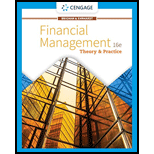
Case summary: Company HH is a regional hardware chain which is considering acquiring LL. The boss of the company asked to place a value on target. There are 20 million shares @$12 per share with LL. Bet is 1.25 for LL’s stock with risk free rate 5.5% and market risk premium is 4%. 20% of capital structure of LL is financed with debt with 8% interest rate. Federal plus state tax rate is 25% and will remain same even after acquisition. The management of the company HH is asking various questions about mergers and also asking to perform merger analysis based on the given details of Company LL.
To compute: The values of unlevered horizon, current unlevered operating value, horizon value of interest tax savings, current value of interest tax saving. Also, state that the values will be same or different if other firm evaluates the LL’s value.
Want to see the full answer?
Check out a sample textbook solution
Chapter 22 Solutions
Financial Management: Theory & Practice
- Need help! What does "liquidity" refer to in finance? A) The profitability of a companyB) The ability to meet short-term obligationsC) The total assets of a companyD) The debt-to-equity ratioarrow_forwardI need answer in this problem!! What does a negative net present value (NPV) indicate? a) The project is profitable.b) The project is not viable.c) The project’s return is equal to the discount rate.d) The project has no cash inflows.arrow_forwardWhat does "liquidity" refer to in finance? A) The profitability of a companyB) The ability to meet short-term obligationsC) The total assets of a companyD) The debt-to-equity ratioarrow_forward
- What does a negative net present value (NPV) indicate? a) The project is profitable.b) The project is not viable.c) The project’s return is equal to the discount rate.d) The project has no cash inflows. I need help in this .arrow_forwardNo Ai The time value of money concept is based on the idea that: a) Money loses value over time.b) A dollar today is worth more than a dollar tomorrow.c) Future money is worth more than present money.d) Inflation has no effect on money.arrow_forwardThe time value of money concept is based on the idea that: a) Money loses value over time.b) A dollar today is worth more than a dollar tomorrow.c) Future money is worth more than present money.d) Inflation has no effect on money.arrow_forward
- What does a high price-to-earnings (P/E) ratio indicate? a) A company is undervalued. b) A company is overvalued. c) High investor confidence. d) Low profitability. need help!!arrow_forwardWhat does a high price-to-earnings (P/E) ratio indicate? a) A company is undervalued. b) A company is overvalued. c) High investor confidence. d) Low profitability.arrow_forwardNo ai What does a high price-to-earnings (P/E) ratio indicate? a) A company is undervalued.b) A company is overvalued.c) High investor confidence.d) Low profitability.arrow_forward
- What does a high price-to-earnings (P/E) ratio indicate? a) A company is undervalued.b) A company is overvalued.c) High investor confidence.d) Low profitability.arrow_forwardThe risk that cannot be eliminated through diversification is called: a) Market riskb) Credit riskc) Diversifiable riskd) Operational riskarrow_forwardNo AI The risk that cannot be eliminated through diversification is called: a) Market riskb) Credit riskc) Diversifiable riskd) Operational riskarrow_forward

 Intermediate Financial Management (MindTap Course...FinanceISBN:9781337395083Author:Eugene F. Brigham, Phillip R. DavesPublisher:Cengage Learning
Intermediate Financial Management (MindTap Course...FinanceISBN:9781337395083Author:Eugene F. Brigham, Phillip R. DavesPublisher:Cengage Learning Intermediate Accounting: Reporting And AnalysisAccountingISBN:9781337788281Author:James M. Wahlen, Jefferson P. Jones, Donald PagachPublisher:Cengage Learning
Intermediate Accounting: Reporting And AnalysisAccountingISBN:9781337788281Author:James M. Wahlen, Jefferson P. Jones, Donald PagachPublisher:Cengage Learning



